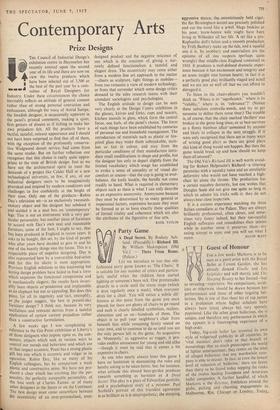Contemporary Arts
Prize Designs
THE Council of Industrial Design's exhibition centre in Haymarket has recently entered upon the second year of its life and there are now on view the twelve products which have been selected out of 3,500 as
le a the best of the past year by a com-
mittee of Royal Designers for Industry. Under these circumstances the choice inevitably reflects an attitude of general consent rather than of strong personal conviction and enthusiasm, although the voice of Astrid Sampe, the Swedish designer, is occasionally apparent in the panel's printed comments, making a quiet, firm gesture of dissent as if itching to make her own prejudices felt. All the products have a tactful, tasteful, reticent appearance and I should not have been surprised to find that all of them, with the exception of the profoundly conserva- tive Wedgwood dinner service, had come from the same studio. But on further reflection one recognises that this choice is really quite appro- priate to the state of British design. Just as we have not the architectural spirit to meet the demands of a project like Calder Hall or a new technological university, so few, if any, of our industrial designers seem to be imaginatively provoked and inspired by modern conditions and challenges to live confidently at the height of their time. Only one of the products—Robin Day's television set—is an exclusively twentieth- Century object and the designer has subdued it and stabled it in a neat box on 'contemporary' legs. This is not an instrument with a very par- ticular personality, but another piece of furniture to accord with Day's own neat and reasonable furniture, some of the best, l ought to say, that has been produced in England in recent years. It asks to be bought, this set, by the kind of people who after years have decided to give in and let one of the beastly things into the house. This is a respectable piece of negative designing. Day is also represented here by a convertible bed-settee and for this his idiom is most appropriate. Previous English solutions to this interesting but testing design problem have failed to find a form Which expresses the functional compromise and is mechanically elegant; the results have invari- ably been objects as'ponderous and implausible as an elephant but not so appealing. But does this piece, for all its ingenuity and tact, exemplify, as the judges suggest, 'the best in present-day furniture design'? 1 think not, because its very tactfulness and restraint derives from a tasteful application of certain current prejudices rather than a constructive formulation.
A few weeks ago I was complaining in reference to the Gio Ponti exhibition at Liberty's of those designers who impose upon us, the con- sumers, objects which seek in various ways to control our moods and behaviour and which are in that respect eccentric, Ponti has a strong plastic gift but one which is eccentric and vulgar in its operation. Robin Day, like so many of his English colleagues, has by comparison a weak plastic and constructive sense. We have not pro- duced a chair which has anything like the per- sonality, the perfectly acceptable personality, of the best work of Charles Eames, or of many other designers in the States or on the Continent. The best design must come somewhere between the eccentricity of an over-personalised, over-
designed product and the negative reticence of one which is the outcome of giving a nar- rowly defined functionalism a tasteful and elegant dress. The eccentricity may come either from a modern fine art approach to the matter —chairs as sculpture, light fittings as mobiles— from too romantic a view of modern technology, or from that surrender which some design critics demand to the sales research teams with their attendant sociologists and psychologists.
The English attitude to design can be seen very clearly at the Design Centre exhibition in the glasses, knives and forks, cups and saucers, kitchen utensils in glass, which form the central focus, one feels, of the panel's choice. The form of such things have been established by centuries of personal use and household management. The introduction of materials such as plastic or fire- proof glass may make them unbreakable, stain- less or fast in colour, and may from the particular conditions of their manufacture intro- duce small modifications in shape and profile, but the designer has only to depart slightly from the limited vocabulary which usage has established to evoke a sense of unreality or of visual dis- comfort or unease—that the cup is going to over- balance, the knife buckle, the handle not come readily to hand. What is required in elementary objects such as these is what I can only describe as an expressive anonymity. Anonymous because they must be determined by so many general or impersonal factors, expressive because they must be formed so as to have exactly those qualities of formal vitality and coherence which are also the attributes of the figurative or fine arts.
BASIL TAYLOR


































 Previous page
Previous page